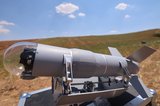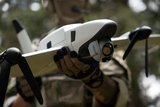Horizon's AEROPAK powers RUSSIA's first hydrogen fuel cell UAV flight
In a pioneering success by the P.I. Baranov Central Institute of Aviation Motors (CIAM) in Russia, the first hydrogen fuel cell powered CIAM-80 unmanned aircraft took off last week at a test flight facility near Moscow.
The CIAM-80 mini-UAV was powered by the ultra-light AEROPAK hydrogen fuel cell system designed by Horizon Energy Systems of Singapore. According to the CIAM specialists, "although the test flight only lasted several minutes, it opened a new era in the evolution of aviation power-plants, reviving research which had been interrupted in the 1990s. In the long term, this type of innovation could double the efficiency of aviation engines while simultaneously eliminating harmful emissions.
Horizon's AEROPAK proton exchange membrane electrochemical system is specifically designed for mini-UAV propulsion, and was enough to power the electric motor on-board the CIAM-80 UAV. Designers used compressed hydrogen storage as a first step, and were successful in integrating the fuel cell power system cooling and complex control systems. Further tests of a UAV demonstrator aircraft are expected in order to confirm the efficiency of fuel cells for use in aviation.
"The AEROPAK fuel cell system from Horizon Energy Systems is currently enabling a number of electric-powered flight pioneers around the world. Small 5-10kg class electric powered unmanned reconnaissance aircraft which are already in use today are the first real-world commercial application for this technology," said Gareth Tang, Managing Director of HES. "Due to the energy density advantage, electric powered aircraft could potentially fly much further using our hydrogen fuel cell solutions."
Source: Horizon Energy Systems
More from Uncrewed Vehicles
-
![What's next for the Pentagon after the Replicator programme?]()
What's next for the Pentagon after the Replicator programme?
Although the Replicator initiative has made several accomplishments, there are still multiple gaps to plug across the US Department of Defense (DoD) and its services.
-
![Cummings Aerospace showcases Hellhound loitering munition designed for US Army’s LASSO programme (video)]()
Cummings Aerospace showcases Hellhound loitering munition designed for US Army’s LASSO programme (video)
Cummings Aerospace presented its turbojet-powered Hellhound loitering munition at SOF Week 2025, offering a man-portable solution aligned with the US Army’s LASSO requirements.
-
![SOF Week 2025: PDW unveils attritable FPV drone for SOF operations at scale]()
SOF Week 2025: PDW unveils attritable FPV drone for SOF operations at scale
PDW has revealed its Attritable Multirotor First Person View drone at SOF Week 2025, offering special operations forces a low-cost, rapidly deployable platform for strike and ISR missions, inspired by battlefield lessons from Ukraine.
-
![SOF Week 2025: Teledyne FLIR white paper provides guidance on reusable loitering munitions]()
SOF Week 2025: Teledyne FLIR white paper provides guidance on reusable loitering munitions
Teledyne FLIR is highlighting the emerging requirements for 'recoverable and re-usable' loitering munitions across the contemporary operating environment during this week’s SOF Week conference in Tampa, Florida.
-
![SOF Week 2025: Kraken Technology group debuts K3 Scout USV in North America]()
SOF Week 2025: Kraken Technology group debuts K3 Scout USV in North America
High-performance maritime industry player Kraken Technology Group, based in the UK, has used the SOF Week conference in Tampa, Florida this week to debut its K3 Scout uncrewed surface vessel (USV) to the North American market.
-
![Palladyne AI and Red Cat to demonstrate capabilities for autonomous drone swarms to the US military]()
Palladyne AI and Red Cat to demonstrate capabilities for autonomous drone swarms to the US military
Red Cat and Palladyne AI recently conducted a cross-platform collaborative flight involving three diverse heterogeneous drones.

























